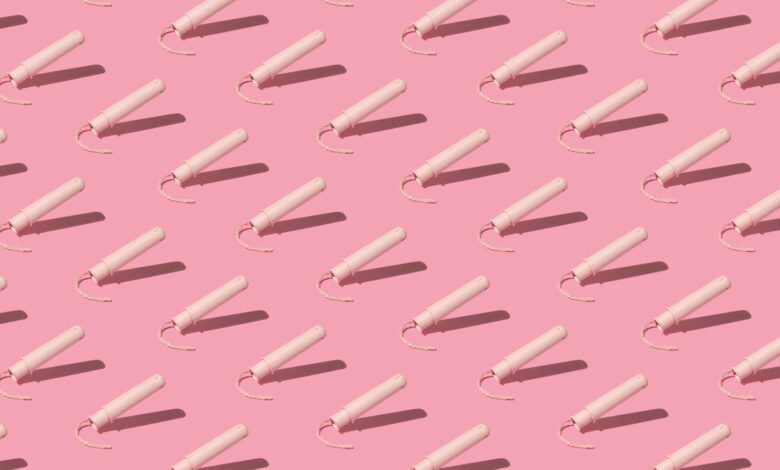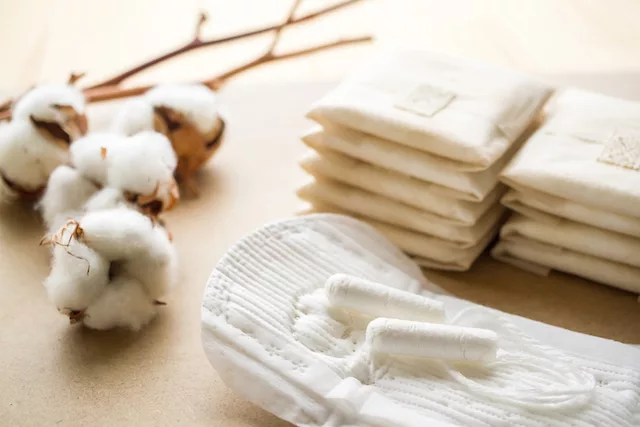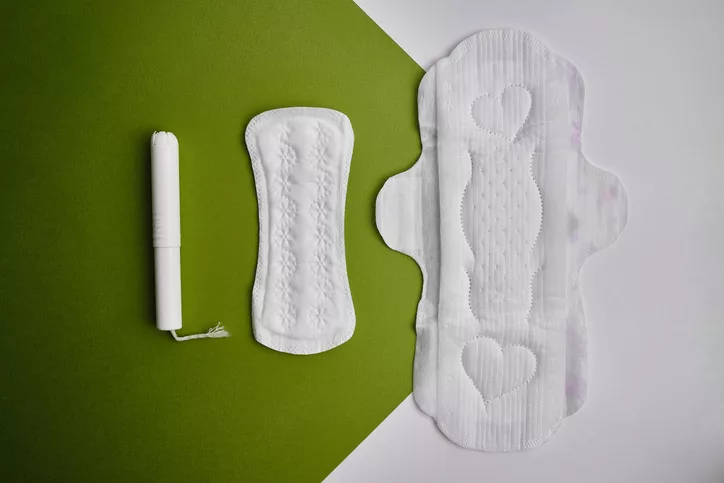How to have an eco-friendly period routine

Curious how you can have a sustainable menstrual cycle routine? It’s possible. Embracing organic, eco-friendly, and non-toxic alternatives can help your monthly carbon footprint and your body. We dive into the reasons behind transitioning from commercial options, exploring eco-conscious solutions, and highlighting the benefits of period cups for a healthier and more environmentally friendly period experience.
Here in 2023, more and more people are searching for ways to live more sustainable lifestyles. Adopting slow fashion and secondhand shopping, prioritizing recycling, and being mindful of the foods you eat are just a few ways to reduce your carbon footprint. Another? Embracing an eco-friendly period routine.
Chances are, you’ve been following the same period routine you have for years, likely reaching for popular tampon and/or pad brands. Nowadays, though, menstrual care has evolved. From period cups and bleed-friendly period underwear to organic feminine care products, there are so many “greener” alternatives for that time of month. Keep reading to learn more about what they are, and why they might just be a better fit for your routine and the environment.
The Downfalls of Chemical-Laden Period Products
Many conventional period products, like Tampax Pearl Tampons and Always Menstrual Pads, might be staples on the period aisle but in the past decade, they’ve been shown to contain reproductive toxicants, formaldehyde-releasing preservatives, and potentially carcinogenic chemicals, as well as PFAs and BPA (AKA plastics). According to Eco Warrior and Founder and Owner of Natracare, Susie Hewson, these chemicals show up in menstrual products as dyes and super absorption, among other things. “PFAs are widespread, and BPA is commonly used in plastics—both are linked to cancer and will mess up the menstrual cycle,” she warns. So, while they may seem necessary for an effective period product, a growing number of women’s health experts are beginning to believe that they can actually cause more harm than good.
Chemicals
“Chemical laden products can irritate labial vulvar and vaginal tissue, and change the pH of the vagina, resulting in overgrowth of normal vaginal flora, leading to vaginitis,” says OB-GYN Dr. Candice Wood, who is the founder of Woman Made Well. “There is also the potential that chemicals could be absorbed through the vagina and cause problems throughout the body.”
Testing
Although there is growing concern for the chemicals found in menstrual products, board-certified OB-GYN and midlife expert at HerMD, Dr. Taniqua Miller, says that there are unfortunately no adequate ways to test for these levels in the products themselves at home. Furthermore, she says that there is “currently inadequate evidence that the chemicals cause harm in humans, such as cancer.”
Concern
The concern surrounding conventional menstrual products doesn’t stop at the chemicals within them, though. The packaging they’re housed in—plastic wrappers and tampon tubes, in particular—litters landfills. “Traditional menstrual products, like disposable pads and tampons, have considerable amounts of plastic that can take hundreds of years to break down,” Miller says.
As a result of the mere presence of potentially carcinogenic chemicals in everyday items like tampons and pads—things that vagina owners use regularly each and every month—plus the environmental impact of their nature, has led many consumers and brands to search for a solution.
Understanding Eco-Friendly and Organic Period Products
The most popular menstrual care solutions are menstrual cups, biodegradable pads and tampons. Where menstrual cups are reusable and free of BPA and other harmful chemicals, biodegradable pads and tampons are manufactured without harmful chemicals and practically indestructible plastics so that they can easily break down post-use. Additionally, reusable menstrual pads (like the Rael Organic Cotton Reusable Pads, $34) and period underwear (such as the Knix Super Leakproof High Rise, $34) exist, reducing the need for single-use period products. The commonality between these products? They all help reduce a user’s carbon footprint.
Inspired to swap out your conventional tampons and pads? Wood recommends reaching for the following brands: MoonPads, Carmesi, and Public Goods. Other brands beloved by consumers include Natracare, L., The Honey Pot, Cora, Rael, and It’s August.
If you’re looking to transition to a menstrual cup, Wood suggests the following brands: Carmesi, Lunette, Voxapod, Saalt, Flex, and Cora. Other brands that offer highly-rated menstrual cups include Nixit and June
One more thing: If you opt for organic cotton tampons and pads, they benefit more than just your feminine health and the environment—they can help the women working in the fields to harvest the materials necessary to create the products, too. “Organic cotton agriculture means that other women’s menstrual cycles are not disrupted by having to work in pesticide drenched fields day in and day out,” Hewson points out.

The Case for Sustainable Menstrual Solutions
If you’re still not sure if you’re ready to switch to sustainable menstrual solutions, consider this: “There are approximately 1.8 to 2 billion women aged 14-50 in the world,” Wood points out. “With that amount of people menstruating monthly, the amount of waste created by period products has the potential to make a significant impact on the environment. Using products that are reusable, like menstrual cups, or that will biodegrade would decrease the amount of waste, minimizing harm to the environment.” In that way, she says that adopting a green period routine doesn’t only eliminate health risks, it ushers in environmental benefits, too.
Health Considerations
In addition to chemicals and plastics, Wood says that synthetic fibers are present in conventional period products—and they can wreak havoc on your feminine and reproductive health.
“The biggest risk to the vagina is the use of synthetic fibers in a tampon,” she admits. “The synthetic fibers cause the production of a large amount of toxins that are absorbed by the body. It is these synthetic fibers that have been linked to Toxic Shock Syndrome.” While most synthetic materials have been removed due to product standards, she says that viscose rayon is still present in many tampons. Because of this, she emphasizes the importance of sussing out natural and organic period care alternatives. “Using products with only natural ingredients is better for your health even if they don’t absorb quite as good,” she says.
In general, she says that your best bet when shopping with your health in mind is to prioritize menstrual products that are eco-friendly and plastic-, chlorine- and fragrance-free. “[Products that meet these parameters are] less likely to irritate vulvar/labial tissue as well as the vaginal microbiome,” she explains.
Steps to Achieve a Green Menstrual Routine
Achieving a green menstrual routine may feel like quite the process but it can really be as simple as heading to your local drugstore or Target, or placing an order online. Just keep in mind, greenwashing is at large in the period category right now. “Without full ingredient disclosure, claims are easily made,” Hewson says. With this in mind, she suggests looking into the raw materials, processing, and country of origin for your product of choice.
“Validation is critical, so look beyond the single claim [on the box] to get the full facts. Check for valid certification and accreditation from independent bodies. GOTS certified organic tampons do not permit synthetics or plastics of any kind, Government Green label schemes are good also, such as: Nordic Ecolabel, Blue Angel, and Oeko-Tex standard 100.”
Using eco-friendly Products
Once you’ve done your research and have your sustainable menstrual product(s) in hand, you just have to learn how to use them.
As Wood mentioned, organic tampons and pads tend to be less absorptive, so you’ll want to read up on how often you should switch them for adequate period security. (For example, where a traditional tampon may be sufficient for four to eight hours, an organic one may max out at four. Because of this, you’ll have to be patient through trial and error.)
In terms of menstrual cups, it’s best to read the instructions that come in the kit. Generally, brands recommend that you wash the cup before use and only wear it for up to 12 hours at a time. (This may take some getting used to, considering it’s a much longer duration compared to tampons.) Speaking of wear and removal, you’ll want to squeeze the cup to insert it and take it out. Although it has a little tab or loop on the bottom to grip, if you try to yank it out by that alone, it may put pressure on your vaginal canal and/or cervix, as it’s suction-cupped in place, and squeezing the cup is what will release it comfortably.
All this to say, adopting a greener period routine isn’t that challenging. “Using pads or tampons that are organic, chlorine-free, fragrance-free, and undyed are great ways to start an eco-friendly period routine,” Miller says. If you prefer disposable products, she recommends organic cotton and bamboo options (which are also compostable); if you enjoy multi-use products, she says reusable pads, menstrual cups, and menstrual discs are great options.
“Thankfully, there are many different shapes and sizes for menstruators to explore,” she says. “And of course, period underwear, sleepwear, and swimwear enable menstruators to forgo any products or devices. Being able to wash and reuse period wearables is a great way to embrace an eco-friendly period routine.”
Embracing the Green Period Mindset
Sometimes, adopting a green period routine can introduce new scents to your everyday life since, without chemicals and fragrances, there’s nothing to distort your body’s natural aroma. “Treat the menstrual cycle with care and respect the potential impacts of chemicals and materials you put into and on your body to protect your endocrine (hormonal) health and wellbeing,” Hewson says. “Do acknowledge that we have a natural odor that is not unpleasant. If it is, then see a doctor as this may indicate an infection.”

Conclusion
If you’ve been wanting to adopt a more eco-friendly period routine, there are many ways to do so. “The choice to adopt some alternative, eco-friendly menstrual options is exactly that—a choice,” Miller says. “It’s great that there are so many options today that can offer flexibility and fit for any person menstruating. Whether it be a traditional pad or tampon or using a menstrual cup or period underwear, we can all agree that people who menstruate now have choice and freedom.”
Source link
#ecofriendly #period #routine



